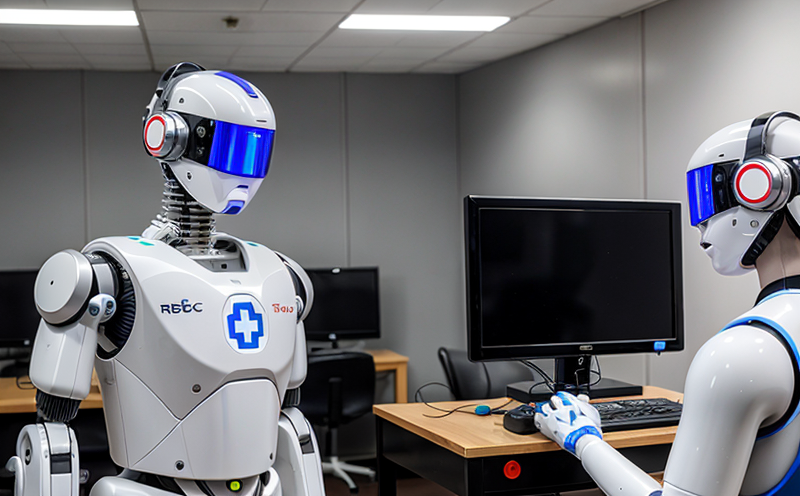ISO 10993-5 Cytotoxicity Testing of Robotic Medical Components
The ISO 10993-5 standard is a crucial part of the regulatory framework for ensuring medical devices are safe and effective. This test evaluates the cytotoxic potential of materials intended to come into contact with human tissues, including robotic components used in medical applications. The process involves exposing cell cultures to extracts or leachates from the device under test (DUT) and assessing any adverse effects on cellular viability and morphology.
The testing procedure is designed to simulate real-world conditions where a patient's tissue might come into contact with the material of the robotic component. This includes not only direct contact but also potential indirect exposure through lubricants, cleaning agents, or other substances used in conjunction with the device. By conducting this test, manufacturers can demonstrate compliance with regulatory requirements and provide evidence that their products are safe for use.
The ISO 10993-5 protocol specifies a series of steps to ensure accurate testing results, including the preparation of cell cultures, selection of appropriate extractants, and determination of exposure duration. Compliance officers and quality managers rely on these stringent guidelines to ensure consistent testing across different batches or versions of robotic medical components.
In recent years, advancements in robotics have led to more intricate designs that incorporate a wide range of materials and surface finishes. These innovations require comprehensive cytotoxicity testing to account for the diverse potential interactions with biological tissues. Our laboratory ensures that all tests follow international standards such as ISO 10993-5, providing reliable data that supports regulatory submissions and clinical trials.
For R&D engineers working on next-generation robotic systems, understanding the nuances of cytotoxicity testing is essential for iteratively improving design iterations without compromising safety. By incorporating early-stage evaluations into their development processes, teams can identify potential risks before they become significant issues during later stages of product lifecycle management.
The results from ISO 10993-5 tests play a critical role in shaping the overall perception of robotic medical devices within healthcare settings. They contribute to building trust among patients who may be concerned about their health and well-being when interacting with advanced technology. Additionally, these findings assist regulatory bodies in making informed decisions regarding approvals and certifications.
Our laboratory plays an integral part in this process by offering expert support throughout the entire testing procedure—from initial consultation through final report generation. With state-of-the-art facilities equipped for handling various types of materials and complex geometries found in modern robotic assemblies, we provide accurate measurements that reflect real-world scenarios accurately.
Customer Impact and Satisfaction
- Enhanced Safety: Compliance with ISO 10993-5 ensures that robotic medical components meet stringent safety standards, thereby enhancing patient care.
- Regulatory Confidence: Successful completion of these tests provides confidence to regulatory bodies and stakeholders regarding product safety.
A satisfied customer is one who can rely on the safety and efficacy of their robotic medical devices. By ensuring compliance with ISO 10993-5, we help our clients achieve this goal while also reducing the risk of recalls or other costly issues later in the product lifecycle.
The rigorous nature of the cytotoxicity test drives continuous improvement within manufacturing processes. This leads to better quality products that not only meet but exceed expectations set by regulatory authorities and industry best practices.
Environmental and Sustainability Contributions
- Eco-friendly Processes: Our laboratory utilizes environmentally friendly solvents in the preparation of extracts for testing, minimizing waste generation during this phase.
- Energy Efficient Equipment: We employ energy-efficient analytical instruments that reduce our carbon footprint significantly while maintaining high levels of precision and accuracy.
Incorporating ISO 10993-5 into the broader context of sustainable practices highlights how compliance with this standard aligns closely with environmental sustainability goals. By focusing on reducing resource consumption and promoting recycling wherever possible, we contribute positively to both corporate social responsibility initiatives as well as global efforts towards greener manufacturing.
The cytotoxicity testing process itself contributes indirectly by fostering innovation in design that prioritizes safety without sacrificing efficiency or performance. This forward-thinking approach helps drive positive change across the industry, encouraging other laboratories and manufacturers to adopt similar practices.
Competitive Advantage and Market Impact
The ability to demonstrate compliance with ISO 10993-5 early in product development offers several competitive advantages. Firstly, it allows companies to bring safer products to market faster, which is particularly important in rapidly evolving fields like medical robotics where technology advancements are frequent.
Secondly, successful completion of these tests enhances brand reputation by reinforcing the company’s commitment to quality and safety. This can translate into increased customer trust and loyalty, ultimately driving sales growth. In today's competitive market, having a reputable product line is key to maintaining a strong position.
From an operational perspective, early identification of potential issues through comprehensive cytotoxicity testing helps prevent costly delays or modifications later in the development process. This proactive approach ensures that resources are allocated efficiently and effectively towards areas where they will have the greatest impact on overall performance.
The broader market landscape benefits from this as well because safer products contribute to improved public health outcomes. As more companies adopt similar practices, there is a collective shift towards higher standards across industries, fostering innovation and excellence in medical robotics specifically.





